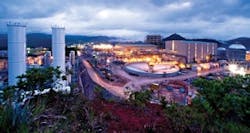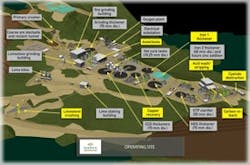However, then and in the centuries since, gold-bearing deposits on the island that includes the Dominican Republic and Haiti were too thinly and widely spread, and so were not worth trying to recover. However, at today's $1,700-per-ounce prices, that calculation is beginning to change, and simulation software is enabling training and optimization to optimize large-scale mining and recovery.
For instance, Barrick Gold Corp., based in Toronto, Ontario, Canada, has been building its huge, new Pueblo Viejo gold and silver mine on the 11-km-square site of a former mine that's been closed for about 10 years, and is located in the middle of the Dominican Republic about 100 km northwest of the capital of Santo Domingo. Barrick operates and owns 60% of the mine, while Goldcorp owns the rest (Figure 1). Meanwhile, Fluor Corp. and Hatch provided engineering, procurement and construction management (EPCM) services for the project.
Managing Multiple Processes
Though much of the site's ore is located close to the surface, Pueblo Viejo still requires about 20 diverse sub-processes to extract gold, silver and copper from it. These include crushing, rough grinding, high-pressure oxidizing, counter-current decantation (CCD) washing, carbon-in-leach (CIL), sulfide precipitation and many others, all of which require various operator skills and experience.
For example, the autoclave circuit at Pueblo Viejo houses four of the world's largest vessels for the pressure oxidation of sulfide gold ores (Figure 2). Steam and oxygen are injected into the autoclaves to oxidize the ore. Each autoclave is almost 6 x 40 meters, and ore is retained in them for 60 to 75 minutes at 230 °C and 3450 kilopascals. This process for improving autoclaving was pioneered earlier at Barrick's Goldstrike mine in Nevada, where it helped increase gold recovery from 35% to 85%.
Figure 2: The autoclave circuit at Pueblo Viejo houses four of the world's largest vessels for pressure oxidation of sulfide gold ores. Steam and oxygen are injected into the autoclaves to oxidize the ore.
Pueblo Viejo's many ore-processing applications are controlled by approximately 11,000 I/O points or device signal tags (DSTs), which are managed by a DeltaV distributed control system (DCS) from Emerson Process Management and PLCs from Rockwell Automation.To help optimize Pueblo Viejo's many processes beginning at start-up, process systems engineer Paul Yaroshak reports that Barrick decided to simulate about 10 processes to help train its operators before the facility began processing ore. However, because of economic and time constraints, Pueblo Viejo couldn't simulate all of its processes, so it decided to focus on those with appropriate complexity, criticality and similarity to other processes, such as limestone crushing, which is representative of other crushing processes at the site. Other simulated processes include copper recovery, pressure oxidation in the autoclaves, iron precipitaion, cyanide destruction, acid wash/stripping and the CIL circuit (Figure 3).
Figure 3: Barrick's engineers focused on simulating processes with appropriate complexity, criticality and similarity to other processes, such as limestone crushing, copper recovery, autoclaves, iron precipitation, cyanide destruction, acid wash/stripping and carbon-in-leach (CIL) circuit.
Most of the operators were new to mining and Pueblo Viejo's equipment, and there were also some language barriers among the staff. As a result, Pueblo Viejo's Ready for Start-Up (RFSU) program was developed, and included training on process fundamentals using computer-based interactive modules and simulator-based training, as well as field demonstrations and hands-on practice."Though the site's overall deposit was exploited previously, we expanded it, so this is a new mine and a totally new processing plant. Our management wanted a safe and secure transition from project construction to regular operations," says Yaroshak. "So the main driver for this simulation system was to prepare our operators for start up with unified, hands-on training before the plant was up and running."
Securing Simulations
Consequently, the dynamic process simulation system, MiMiC from Mynah Technologies, was supplied and implemented jointly by Lakeside Process Controls, an Emerson distributor that also provided project management support, and the Pueblo Viejo process group. MiMiC was picked because it provided required low-, medium- and high-fidelity levels as needed; integrated seamlessly with DeltaV; was already being used by the EPCMs for checking I/O; was intuitive; and allowed easy change for model and control system enhancements.
Pueblo Viejo's MiMiC simulations consist of 10% low fidelity with basic I/O tiebacks and simple tuning; 60% medium fidelity with engineering first principles and conservation of energy and mass; and 30% high fidelity with mass/energy transfer equations, differential equations and empirical models. Models for the each of the plant's 10 processes to be simulated were built using an iterative process, which begins with a first-principle Excel model; adds the DeltaV configuration; uses MiMiC to perform simulation conversion and I/O tie-backs; creates medium- and high-level models; builds trainee screens; and finally conducts an initial review, makes changes, and completes a final review.
"We picked these 10 processes because they're complex, critical, often involve high temperatures and pressures, impact other process, and require high degrees of customization during operations," says Yaroshak. "So, simulating each of these processes gives us a solid base of training modules that can be used to prepare operators for scenarios they could encounter in the real-world plant, and gives us a lot more bang for our buck."
Partners in Virtual Training
Figure 4: DeltaV Simulate software recreates
controllers on a standard PC where all DeltaV
logic and operator graphics remain intact, while
MiMiC's process models simulate I/O and process
dynamics from field devices to the controllers to
provide a realistic process response. Combining
DeltaV Simulate, MiMiC and actual DeltaV control
logic and graphics creates a complete, virtual
plant environment for training and testing.
The plant's simulation environment includes DeltaV Simulate software that simulates the DCS's controllers on a PC where all DeltaV's logic and operators graphics remain intact, while MiMiC simulates I/O to the controllers in DeltaV Simulate Process models to give a realistic process response. Combining DeltaV Simulate, MiMiC and actual DeltaV control logic and graphics creates a complete, virtual plant environment for training and testing (Figure 4). Meanwhile, the operator training system includes four DeltaV workstations and a MiMiC server, which allows the instructor to launch four training scenarios at the same time, including introducing potential problems and failures to gauge operator response.
Unalloyed Advantages
Thanks to implementing its multiple simulations, Yaroshak reports that Pueblo Viejo reduced commissioning time by finding usability and logic issues earlier, and enhanced the new operators' familiarity with their equipment and processes. Many HMI issues were also discovered through extensive use of the simulators with operations staff that were consequently fixed and tested well ahead of commissioning.
"The key challenge in mineral processing control is dealing with the variability of ore, such as varying hardness, mineral content and other elements that can help or hurt recovery," adds Yaroshak. "Our processes need robust logic to effectively respond to these changes, and simulations help us to better understand process interactions, remove bottlenecks, and provide insight for managing variability.
"Likewise, our training simulations include using actual screens and graphics with realistic process dynamics and responses, which force operators to react in real-time to different alerts, alarms and process interlocks, and prepares them to handle many situations and failures. The old way would have been to wait until the plant was running to do this kind of training, so the simulations buy us a lot of time. We're also using our simulation to develop testing of configuration and function logic within our DCS, so we can evaluate and fine tune interactions between different elements of the control system, and make sure they're working together as designed and intended."
How to Build a Gold Mine
There are two informative videos about how Barrick Gold, Fluor and their many partners built the Pueblo Viejo gold, silver and copper mine. They're located at:
Fluor is providing engineering, procurement, and construction management (EPCM) services for the $3.8 billion Pueblo Viejo Project, the largest foreign investment in the history of the Dominican Republic.











